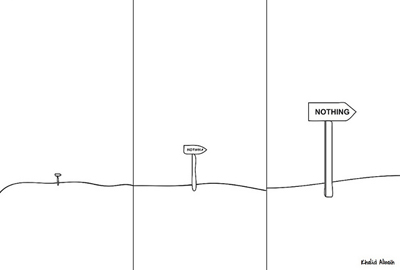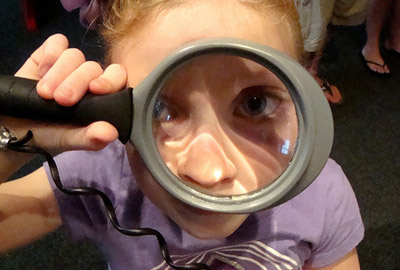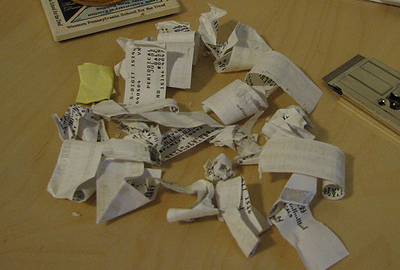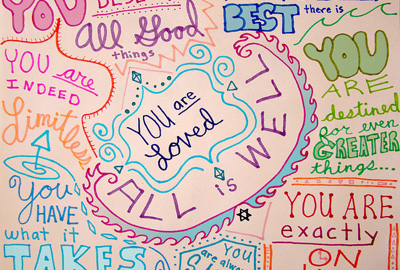I love this expression. It reminds me of the perils of venturing, unchaperoned, into the ruts and rubble of my unexamined thoughts and beliefs.
I am also reminded that a “bad neighborhood” can look very different to different people.
But one thing remains consistent: It is a place where we don’t feel safe. A place where we are at the risk of being irrevocably changed. And not in a good way.
 I am a classic example of the risks of unaccompanied brain excursions.
I am a classic example of the risks of unaccompanied brain excursions.
I’ve been known to take an innocent phrase from the mouth of a friend and turn it into a personal indictment of my entire way of life. I inevitably find – when I bring my persecution theories into the light of reality – that any indictment was a fabrication of my own mind.
My pesky, over-active, reality-warping mind.
Thankfully, the world has a superhero to combat such distortions.
If you’ve never heard of him, you’re about to:
It’s a bird!
It’s a plane!
It’s . . . . David Burns!!!
 I was first introduced to his work almost thirty years ago. Dr. Burns wrote a book called Feeling Good, outlining a cognitive-therapy approach for the treatment of depression.
I was first introduced to his work almost thirty years ago. Dr. Burns wrote a book called Feeling Good, outlining a cognitive-therapy approach for the treatment of depression.
Now before you stuff a fist into your mouth to stifle a yawn, let me say this:
Dr. Burns did not get his superhero status for nothing.
This guy has some serious mojo. Some serious skills. Some hard-core,
life-changing-and-rearranging tools. Ten of them, in fact.
Here’s the deal:
In his book, he describes ten ways that our minds distort reality. When we become aware of these distortions, we can start to combat the dangerous, shape-shifting tendencies of our minds.
Our minds can become safe havens once again.
And who doesn’t want to frolic freely in their own mind?
Don’t answer that. Just listen.
Here are the Ten Ways Our Minds Mess With Us:
1. All or Nothing Thinking
This particular brand of distortion often comes into play when we’re evaluating our own skills and abilities. One small mistake, and we tell ourselves we’re total losers.
No we’re not! Our minds are just cancelling out all shades of gray and viewing the world in black and white. A world that doesn’t exist.
2. Overgeneralization
This describes the tendency to take one small “negative” event and blow it up into a supposed “pattern” of defeat. A friend lets us down and we declare that no one is ever there for us. We take one event and turned it into a “trend.”
But the only place the “trend” exists is in our heads!
Tricky tricky!
3. Mental Filter
 Let’s say someone says something mean to you. Let’s say you spend the rest of the day focusing solely on that one comment. Let’s say, after a day of such focus, you feel like crap. Wanna know why?
Let’s say someone says something mean to you. Let’s say you spend the rest of the day focusing solely on that one comment. Let’s say, after a day of such focus, you feel like crap. Wanna know why?
Because you’ve filtered out everything except the one negative event that happened to you all day.
And that’s what we called a mental filter.
4. Disqualifying the Positive
As if blowing up the negative events in our lives wasn’t enough, how about this one: Someone says something kind to us – perhaps a compliment, perhaps a congratulatory remark. What do we do?
We tell ourselves they’re lying. We tell ourselves they didn’t mean it. We take what is good and right and positive and turn it into a small, shriveled speck of a thing.
WTF?
5. Jumping to Conclusions
You’ve heard the expression “Jumping for Joy.” That’s not what this is. This is a leap into a pile of dung. A pile of dung made just for you.
Oh joy!
This particular mental distortion usually relies upon “psychic” skills. And by “psychic” I mean – totally made up.
Like this: You email your friend Ricky a question and Ricky doesn’t respond. You use your pseudo-psychic skills to determine that Ricky is mad at you. When a few days go by and you still haven’t heard from him, you decide the friendship is over.
Now you don’t care if Ricky is mad at you, because you’re mad at him. In fact, you’re furious. What a jerk!!
A week later, you find out Ricky never got your email.
Whoops.
6. Magnification and Minimization
Another mental sleight-of-hand in which everything positive appears
eensy-weensy teeny-weeny, and everything negative looms large.
Our skills and abilities are “no big deal,” “nothing, really,” and our faults are “huge and enormous” and “totally suck.”
Good times!
7. Emotional Reasoning
I love this one. You feel like crap. Therefore, you decide – in your enormous wisdom – that everything you see and think, and everything you’ve ever seen and thought, and everything you’re ever going to see and think is . . . you guessed it . . . crap!
You let your crappy emotions drive the bus. And then the bus goes to
Crap-ville.
What a surprise.
8. Should statements
These are fun: I should have done a better job. She should be nicer to me. I should be a better unicyclist. Or whatever.
If the word should is involved, there’s trouble. Trouble you should avoid. (Sorry, I couldn’t help it.)
9. Labeling and Mislabeling
We take one personal trait – usually a less-than-flattering one – and use it to label our entire being: Stupid. Lazy. Forgetful. Mean. Not only is this totally ridiculous, but it’s totally ridiculous.
We are not just One Thing. And we’re certainly not just One Negative Thing. But our mind gets this bone in its mouth and keeps gnawing and gnawing and gnawing.
Talk about painful!
10. Personalization
 A classic. Somebody does something that has nothing to do with you and you take it on. Parents and teachers and helpers of all stripes are particularly susceptible to this one. Your child/student/helpee falters in a task and it’s your fault.
A classic. Somebody does something that has nothing to do with you and you take it on. Parents and teachers and helpers of all stripes are particularly susceptible to this one. Your child/student/helpee falters in a task and it’s your fault.
As if!
As if you control the world. As if you control anyone but yourself.
Yet Personalization would have you believe otherwise. Thus creating misery in its wake.
 And those, my Goofball friends, are the 10 ways your mind messes with you.
And those, my Goofball friends, are the 10 ways your mind messes with you.
Now before you go getting all hopeless and helpless – But Dr. Z, my mind is always going to be pitted against me! That’s just the way it is! – remember this:
We all have “negative” thoughts. The more you can be aware of them, especially if you can start to categorize them and discern their nonsensical nature, the less they will affect you.
In my current class on “Spirituality in the Brain” for Holmes Institute, our professor, Mark Waldman, noted that over three hundred studies have shown that bringing awareness to negative thoughts defuses them.
In other words, if you can start to notice yourself doing just one of these ten patterns, you’ve started the process of shining a light on your negative thoughts, thus diminishing their power.
Speaking of diminishing power, pitting these 10 patterns against the Truth is always a good strategy. When faced with the question: “Is it true?” – none of these distortions can pass the test.
So the next time you find yourself going to Crapville, review your thoughts.
Take out the list of 10 distortions and pinpoint which one – or ones – your mind is activating. Then replace the distortions with the truth. It may be helpful to write out the truth in the form of an affirmation and repeat it to yourself throughout the day.
After all, the negative thought was probably on a repetitive loop – why not put the Truth there instead?!
The more you can sniff out these distorted patterns and replace them with positivity, the more habitable your mind will become.
The 10 Distortions will become the 10 Truths!
No longer will you need to worry about venturing, unchaperoned, into the muck of your mind! What once was a House of Horror will become a Palace of Possibility!
Which of these patterns do you recognize in yourself? And what’s the Truth behind the distortion?
















SOLD ! …even in a crappy market.
THanks
Thanks, Dianne! David Burns should get the commission on the sale. 😉
good morning, z! happy tuesday!
i would like to say, “i don’t know what you’re talking about, crazy woman, that is not my experience AT ALL.” i said, i would LIKE to say it, but it would be a total fabrication; i recognize every last one of them. and i’ve experienced all of them recently, in one are of my life or another.
i think if i can be aware of the thoughts, feelings and beliefs and know that they are all fabrications, and insert “perfect, whole, and complete” after “i am,” then i can start to shift that and see myself through the eyes of love. a practitioner once told me, “you’re a mess, but you’re a divine mess” and if i can get that, like, really GET it, i’ll be able to facilitate a safer head space.
not sure if my ramblings have anything to do with the post or even if they make sense, but there you have it…
have a great day!
much love to you.
Hello, You Divine Mess of a Squirrel, You!
Yes, we are all Divine Messes, aren’t we?! I think that this idea is totally applicable to this post. After all, the posts outlines 10 ways in which we become messes. And then, as you so astutely point out, since we are all Divine messes, we always have a way out.
One of the things I love about Dr. Burns is that he points out that just being aware of our “messiness” helps us get out of it. Again, back to your phrase – we are all messes. And awarenessness of this fact makes us Divine messes! Though, ultimately, we’re all Divine, whether we know it or not.
How’s that for messiness?
XOZ
Thanks Z. I’ve just ordered Feeling Good for my mom.
Hi Cathy, That’s great. The book is packed with all kinds of great info about turning around “cognitive distortions” as Burns calls them. Hope your mom finds it useful! XOZ
Have experience with most of the above. The one that kind of dogs me more often is the “should’a”. It’s out of the realm of my control, because it’s usually about some past errors of judgment or behavior. I know I have to forgive the past (give up the hope that it could be different), but I stubbornly won’t let go completely of these tapes. Wonder if it’s just the familiarity of old stale negatives about what I didn’t do–can we possibly be comfortable recycling uncomfortable thoughts?
I like what the Caring Nurturer used to say “Stop Should’ing on Yourself”!
I also like Deepak Chopra’s advice on the negative ones–just say “Next…”.
It seems we can’t hear these kind of guidelines often enough—good job!
“Shoulds” are tough, aren’t they?! Like a nagging critic inside our heads. I like your inclusion of Chopra’s advice: “Next. . .” I hadn’t heard that before. I also like responding to the voices with: “Thank you for sharing.” And then countering their “shoulds” with more constructive, positive ideas. Thanks for stopping by -great to hear from you! XOZ
Hi Z, good stuff. My personal favorites are “personalization” and “jumping to conclusions.” This is how that looks:
My husband is in a bad mood, so it MUST have something to do with me. He must be mad at me for something he perceives that I did. Then I stew about the unfairness of him being mad at me when I didn’t even do anything wrong! Jerk.
Oh, dear…
Hi Jill, That’s pretty advanced – combining two distortions into one! I almost want to congratulate you! Instead, I will congratulate you on your awareness of your advanced maneuver. And your willingness to laugh at yourself. Always a good thing. 🙂 XOZ
Personalization. I wasn’t aware of how many times I do this until I read your blog. Yesterday I was witness to an incident that happened to another person and when I said something about it, this very wise person said to me, “it’s okay, I am trying not to make up a story around it”. I have been thinking about those words ever since and realizing how often I have been doing just that. You just gave it a name, thanks Z.
Hi Fran! Actually, it was the superhero, David Burns, who gave it a name. His work is really amazing. The funniest thing is that we all do this stuff every day. Our minds are wacky places, really. Glad that you enjoyed the post. Great to hear from you, as always! XOZ
I just left that crappy neighborhood, hope I don’t have to revisit it again. Man was it crappy, I think I will just get me some God, and keep loving me up.
Thanks Z your the bomb, just sayin
Hi Susan,
Congratulations on leaving the Crappy Neighborhood. That’s a big step! Sending lots of love your way, my friend.
XOZ
Hey Z! I love this! I just went through several of those numbers this past weekend. Funny how I thought I was THE ONLY ONE in the whole world who struggled with this. Like I was doing one of those mind traps ABOUT being a mind trap. Mental moebius strip or existential emotional escher!
Kayla
Hi Kayla,
That should almost be #11: thinking that you’re the ONLY one who does this! 🙂
I like your phrases for it. Do you think that an “Existential Emotional Escher” could be acted out? Like, an interpretive dance? Or, better yet, a mime?! Hmmmm.
XOZ
I could definitely see Existentialist Emotional Escher being a translated into a mime piece. Woo-hoo. I think the interpretive dance would go well with Mental Moebius…people climbing all over each other and no one knows where anyone else begins or ends. 🙂
Like a Goofball Circus of Cognitive Distortions! Good times!! 😉